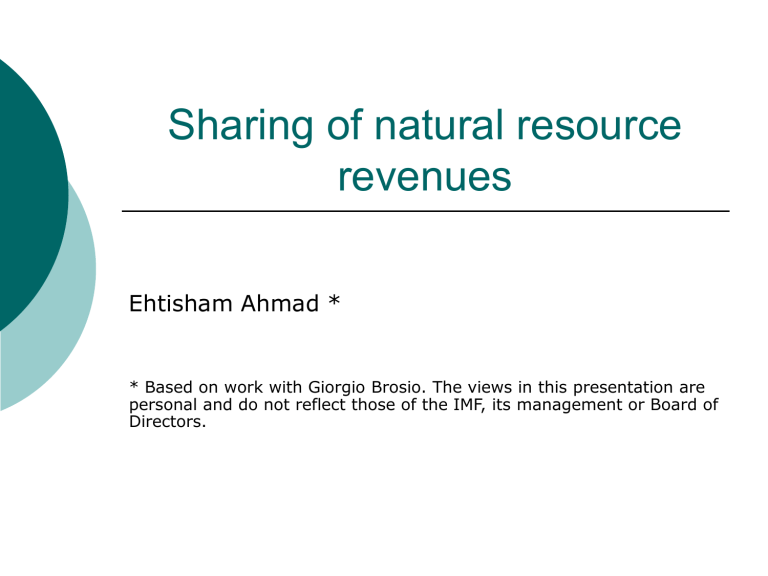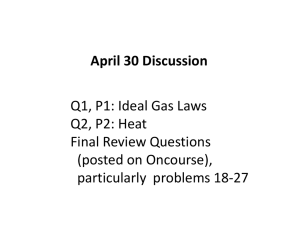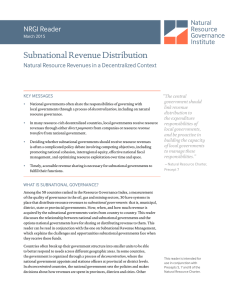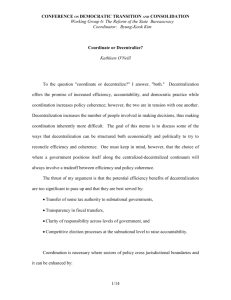Sharing of natural resource revenues

Sharing of natural resource revenues
Ehtisham Ahmad *
* Based on work with Giorgio Brosio. The views in this presentation are personal and do not reflect those of the IMF, its management or Board of
Directors.
Issues
Instruments choice: assignment of own-revenues from natural resources
Efficiency considerations
Accountability
Macroeconomic issues
What does experience show?
Political economy considerations
Transparency for good governance
For discussion of Political Economy considerations see: Ehtisham
Ahmad and Giorgio Brosio (eds), 2006, Handbook of Fiscal
Federalism; and Ehtisham Ahmad and others: Emerging
Issues in Fiscal Federalism (forthcoming)
For transparency related issues: IMF, 2007, Guide on Resource
Revenue Transparency
Stylized facts
Characteristics of natural resource exploitation:
Huge geographic concentration of production;
Sparsely populated regions may exercise small weight in national politics;
Large disparities in per capita revenue of subnational units;
“Boomtowns” phenomenon;
Large, but unpredictable, fluctuations of price;
Growing demands from producing area to retain a (large) share of oil rent create pressures, rivalries and strain on national unity.
Instruments for sharing “economic rent” between levels of government
Separation of taxes: for example, royalties to subnational governments and income tax to central government, or vice versa;
Concurrence of taxes: each level of government levies taxes on oil rent (tax base sharing);
Revenue sharing: revenue is collected by one
(usually, the central) government only and shared to other levels;
In kind sharing: contractors provide infrastructure to the producing areas;
Intergovernmental transfers.
Illustration of instruments for sharing rent
Separation of taxes : where collection (or revenue), R share, t i
R i
= t i
B
i,
, is equal to locally determined i
, of the locally determined tax base, B
i.
, i is region/state
Concurrence of taxes: where R i
R i
=(t i
+ l i
) B i
, are the total collections in jurisdiction i of the shared tax; li is the locally determined tax rate applied to the nationally determined tax base, B
i.
Local revenue is r i
= l i
B i.
Tax revenue sharing: the tax bases, the tax rates and the revenue shares are determined by the central government and the revenue is allocated according to the principle of origin: r i
= α t B i; or, r i
= α R i.
I nstruments for sharing rents from petroleum with subnational levels of government
Method Own taxes
Determination of the tax base
Determination of the tax rates
Administration
Criterion for determination of the beneficiary jurisdiction
Sub national
Sub national
Sub national
Origin
Sharing of tax bases
National
Sub national
(within limits)
Mostly national
Origin
Sharing of revenue
National
National
National
Origin
Sharing of revenue in kind
Mostly national
Mostly national
By the producing firm
Origin
Intergovernmental
Transfers
National
National
Mostly national
Need, equity or other
Choice of Sharing Instruments
Arguments against subnational taxation of oil
rent:
Complexity of administration: collection by the most efficient means higher revenue;
Delays in revenue accruing to the center
Possible secessionist trends.
Arguments in favor of subnational taxation of oil rent (the point of view of LGs):
Benefits associated with taxing power;
Direct control of revenue
North American models—USA and Canada.
Choice of Sharing Instruments
Arguments against concurrent taxes
Vertical tax competition can lead to greater overall tax burden;
This applies especially to royalties.
Complexity in coordination and administration
Assignment of natural-resource revenue to subnational government
Arguments against sub-national
assignments (all natural resource revenues)
Inefficiency in geographical allocation of factors of production
location of firms in oil producing areas with no comparative advantage;
Inefficient spending due to limited absorption capacity
More resources than needed in Arauca (Colombia);
Cajamarca (Peru)
Possibilities of sub-national corruption;
Volatility in prices: sub-national governments generally less able to absorb.
Assignment of some revenue to subnational government
Arguments for assignment (of some revenues, e.g., production excises)
Localities should finance additional costs of investment in infrastructure.
Peak load pricing: expansion of capacity paid by those who use it
Compensation for environmental damage
Examine adequate instruments for these purposes.
Choice of sharing Instruments
Revenue-sharing is most used :
Political-economy rationale—automatic sharing in national resources
But, difficult to agree on sharing percentage
Acheh discussion
Could enhance regional inequalities
Usually considered as part of a
“package”
Revenue sharing: Alleviate or exacerbate political conflict?
Sharing the “pie” stokes conflict (Nigeria)
Symmetric and contract federalism:
construction of national infrastructure by resource-rich jurisdictions;
Sharing of revenues with all levels of governments
(not only states/regions)
Districts/Municipalities may have different political objectives (Indonesia);
Central government could use intersecting policy instruments,
such as “trade and commerce” clause to build unity
Concurrent use of instruments, including redistributive transfers
Ensures that all regions and governments have stake in the union— with federal management of natural resources
What is the experience?
Issues
What is the practice of sharing of oil-revenue rents in multi-level countries?
What do the numbers tell us?
How to ensure transparency and equitable distribution?
Political economy and maintenance of national unity
Instruments to collect natural resource economic rents
Instruments (as explained in the previous lecture)
Auctioning of exploration and exploitation rights
Government equity in projects
Production sharing
Taxes/royalties
The best strategy for the government depends on its degree of risk aversion.
Political economy constraints are important; and
A combination of instruments may be needed.
Tax instruments
Fixed fees
Specific (or, ad valorem) royalties
non-neutral but largely used
Income tax with-higher-than normal tax rate
Progressive income tax
Resource rent tax
almost neutral allows extraction of total rent
Instruments for sharing rents
Separation of (own) taxes
Concurrence of taxes (tax base sharing)
Revenue sharing
Intergovernmental transfers
Table 1. Classification of Oil Revenue Assignments in Unitary and Federal Countries
Unitary countries
Federal countries
Full decentralizat ion
United Arab
Emirates 1/
Full centralization
Algeria
Azerbaijan
Bahrain
Indonesia (until 2000)
Iran
Iraq (under discussion)
Kuwait
Libya
Norway
Oman
Qatar
Saudi Arabia
United Kingdom
Yemen
Shared revenue bases
Canada
United States
Revenue sharing
Colombia (D)
Ecuador (C)
Indonesia (since
2001) (C)
Kazakhstan
Mexico (C)
Nigeria (D)
Russia (D)
Venezuela (D)
1/ Upward revenue-sharing arrangement.
C: Rather centralizing arrangement.
D: Rather decentralizing arrangement.
Sharing of oil revenues
Considered, or adopted in many parts of the world (Nigeria,
Indonesia, Sudan)
• Political economy arguments widely used
Finance basic expenditures
“persuade” oil producing regions to stay in the federation—political economy
Could finance infrastructure in other regions: national cohesion
Revenue-sharing mechanisms
Oil revenue is collected centrally and redistributed according to a formula
Convenient way to transfer fiscal resources to subnational governments
Can be supplemented by transfers to address equalization concerns or special regional needs
But:
drawbacks for macroeconomic management, including volatility; and
May exacerbate tensions and conflict.
Difficulties with oil-revenue sharing
•Volatility with respect to price (and production) changes
• Difficulty in establishing a percentage
•Indonesia and Nigeria
• May generate unsustainable spending in upturns
• Inadequate revenues for basic spending in downturns
• Inefficiency in geographical allocation of factors of production
• Location of firms with no comparative advantage
Unitary countries 3/
Azerbaijan
Algeria
Bahrain
Colombia
Ecuador
Indonesia
Iran
Kuwait
Libya
Norway
Oman
Qatar
Saudi Arabia
Yemen
Federal countries 3/
Canada
Mexico
Nigeria
Russia
United Arab Emirates
United States
Venezuela
Table 2: Oil Revenue Volatility in Selected Countries, 1997-2000
Oil revenue Volatility
(in percent of GDP) (in percent)
1/ 2/
Total revenue Volatility Oil revenue and grants (in percent) (in percent of
(in percent of GDP) 2/ total revenue)
1/ 1/
16.6
5.7
21.4
13.0
2.6
7.4
5.6
13.3
38.6
23.0
8.9
30.2
16.7
24.6
21.6
12.7
7/
5.3
23.8
3.8
18.2
8/
12.2
27.6
29.1
25.9
26.3
38.3
32.1
32.7
42.0
19.2
8.0
30.8
15.6
27.4
27.4
31.9
28.2
25.9
17.7
39.3
26.4
22.4
31.1
34.6
32.8
19.6
32.7
24.6
27.7
25.1
17.5
25.5
60.7
39.0
52.3
39.5
28.6
33.6
33.1
29.0
46.2
21.5
31.8
13.1
34.6
29.9
25.9
12.6
5.1
13.3
15.1
2.8
15.9
11.5
18.2
13.3
14.7
4.0
6.9
19.9
15.5
20.4
9.9
0.5
4.4
28.6
14.2
6.3
1.6
13.8
48.2
28.6
64.4
51.9
9.4
31.3
31.1
49.8
63.0
59.9
16.9
76.0
57.3
72.0
63.8
44.7
…
24.7
72.4
28.8
52.0
…
45.7
Coverage
General government
Central government
Oil and gas
Nonfinancial public sector
Nonfinancial public sector
Oil and gas. General government. 4/
Oil and gas. Central government. 5/
Oil and gas. 6/
Consolidated government
General government
4/
Central government
Central government
General government. 4/
Public sector. Excludes excises on gasoline
General government
Oil and gas. Federal government
General government
General government. 9/
Public sector (excl. nonrecurrent operations)
Source: Ahmad and Mottu , in Davis, Ossowski and Fedelino (eds.) 2003.
1/ Average during 1997-2000.
2/ Defined as the standard deviation in percent of the mean over the period 1997-2000.
3/ Unweighted average.
4/ Fiscal year starting on April 1.
5/ Fiscal year starting on March 20.
6/ Fiscal year ending on June 30.
7/ Resource revenue in the provinces of Alberta and Saskatchewan.
8/ Oil revenue in the state of Alaska.
9/ Fiscal year ending on September 30.
15
10
5
0
0
30
25
20
Chart 1: Volatiliy of Total Revenue in Selected Oil-Producing
Countries, 1997-2000
10 20 30 40 50
Oil revenue as a share of total revenue
60 70 80
Assigning Revenue Bases
Assignment of specific oil revenue bases to subnational governments
Tax bases may be overlapping
Subnational governments are accountable
National equalization system may take oil revenue into account by not providing or limiting equalization transfers to oil-rich regions
Examples: Canada, United States
Assigning revenue bases (II)
Cover additional costs of investment in infrastructure:
expansion of capacity paid by beneficiaries
Compensation for environmental damage
environmental excise directly linked to production
An oil fund/ “Alaskan dividends”
Providing dividends to citizens directly
Idea of “dividends” appears politically appealing, especially if
Assets managed externally
BUT
“Alaskan fund/ dividends”
With significant deficits, diversion of oil revenues would exacerbate catastrophic fall of spending (e.g., proposals for Iraq)
especially with limitations on
Borrowing
Non-oil revenue sources
May lead to a reduction in needed investment or other priority public expenditures
Amounts to be distributed as dividends would be small (especially if there are considerable external debts)
“Alaskan fund/ dividends” (contd.)
May be difficult to target,
Political economy of by passing weak administration may not be effective—
Still need to be administered
Possibly weaker oversight of fund
May generate a parallel budget, with poor transparency and oversight
Would take years for the dividend to grow into any significant payments
Ensuring transparency
All revenues through central account of
Treasury (TSA)
If stipulated;
Regional shares to regional TSAs from Central
TSA
Transfer mechanisms clearly defined
(discussed by Boadway)
If Stabilization Fund, all resources through budget, and no spending without appropriations
“Norwegian” model
Accountability and transparency
Financial management system design:
Transparency code
Penalties for misreporting and misuse
Probability of detection and oversight
Independent audit (EITI)
Information flows
Centrally determined formats for
Budget classification (GFS2001 and UN COFOG);
Tracking and reporting expenditures
Managing cash
Importance of Treasury Single Accounts
Setting up separate funds could weaken transparency
# Not inconsistent with decentralized operations
Consistent reporting and transparency
Principles common to all level of governments and agencies
Need for timely and complete information on the finances of subnational governments, as well as of the center:
Including information on oil revenues
Assurance through improvement in reporting and audit mechanisms
Require work on the budget classification, common reporting formats
Macroeconomic considerations
Focus on non-oil revenues
Resources as wealth: consume revenues consistent with permanent income expectations
Ossowski and Barnett (2003) in Davis et al
Better position on the macroeconomic stance, risks and long-run sustainability
Evaluation of fiscal risks and contingent liabilities;
including from sub-national operations
PPPs: evaluate full costs and benefits
Do resource related Funds help?
Kuwait future generations; Iran
Preconditions important:
Clear operational rules and responsibilities
Presentation of fund operations to Legislature together with regular budget
No direct spending from the Fund (everything to be appropriated in the budget)
Activities reported to Parliament
Neither Kuwait not Iran meet these conditions
“Norwegian style” stabilization fund
Clear oversight of investments
Subject to strict reporting and audit
Prevents parallel budget arrangements
Transparent mechanisms, but difficult to replicate with weaker political systems
Conclusions
Various instruments available for
“maximizing” the government’s take
Institutional arrangements vary— political economy driving factor
Efficiency, revenue and macroeconomic considerations important
Ensure transparency and good governance











